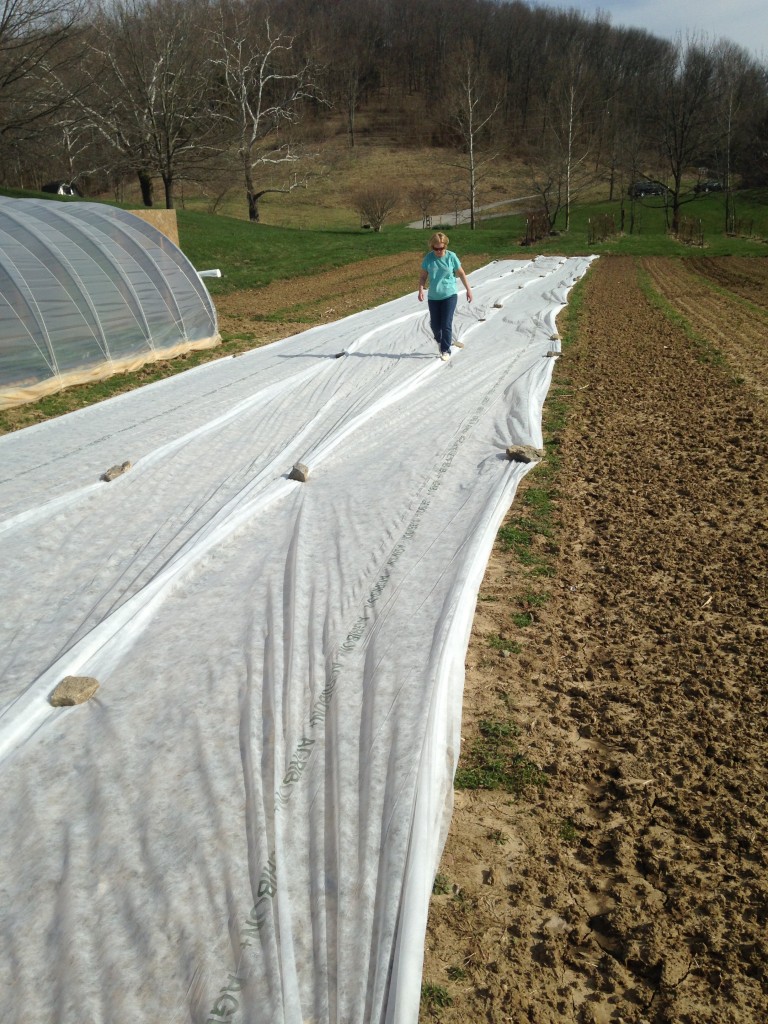If you come visit my stand at the farmers market, you may notice that some of my veggies are on the petite side. That’s because I use my “little pumpkin” philosophy all throughout the garden. My celery is small. So are my eggplants, beets, cabbages, and a bunch of other vegetables. Sometimes it’s because I grow small varieties and plant things close together so I can fit a lot of vegetables in a small space, but oftentimes it’s because I don’t use fertilizer and extra water on the plants. I believe the result is nutrient-dense and flavorful (and not watery) food. Sometimes bigger isn’t always better…sometimes good things come in small packages.
The Bengals Effect
Melon Mistakes
Melon season arrived on the farm last week, and it seems like it will only last another week or so. It’s a flash in the pan, but a sweet and juicy flash in the pan. I have never grown melons before this year. In the Pacific Northwest, where I learned most of my farming skills, it was difficult to grow melons because they like prolonged hot weather. I’ve learned a lot of lessons about growing melons (both cantaloupe and watermelons) this year, mostly from screwing up, so I thought I would share my screw-ups with you all so you too can learn from my mistakes.
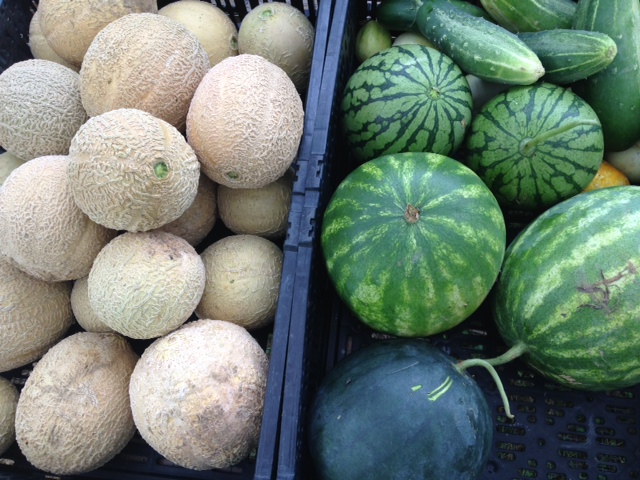
Our first melon harvest for market was August 9. Jackpot!
I thought any melon with orange flesh and tan, rough skin was a cantaloupe. That’s not true! Cantaloupes are a specific type of muskmelon. Other muskmelons include honeydew and Armenian cucumbers. The name refers to the fragrant odor that these melons release when ripe. Technically, the term cantaloupe refers to a specific type of muskmelon from Europe with orange flesh, but no ribs or netting. However, we have more recently accepted the term cantaloupe for all of the sweet, orange fleshed muskmelons with netting and ribs that are so popular in North America. Who knew? Not me, until I read the descriptions of muskmelons and cantaloupes in seed catalogs this winter.
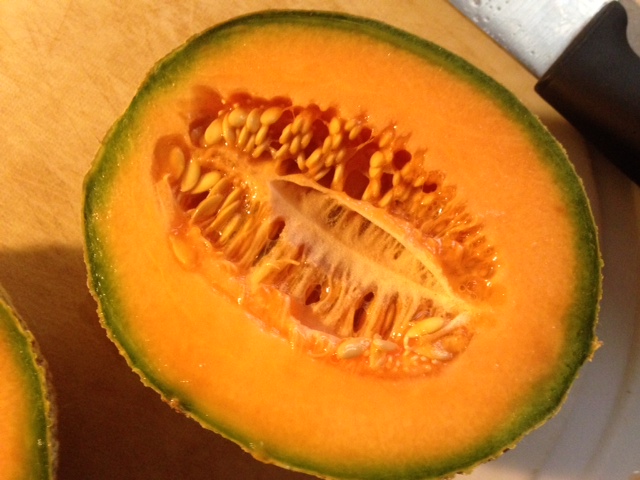
Melons, like their cousins, squash and cucumbers, have very long vines with large leaves. These plants do a great job of spreading and making a canopy of huge leaves, under which weed seeds have a difficult time germinating. Assuming that my baby melon plants would take off and out compete the weeds, I put “weeding the melons” very low on my priority list. The result? My melon patch is the weediest spot on the farm. Name the weed, and I’ve got it in my melon patch. Every time I harvest cantaloupes and watermelons, I feel like I’m on a treasure hunt. As fun as that is, it probably takes me 5 times longer to harvest melons than it would if I could actually see them sitting on the ground.

My favorite variety of watermelon is a small little yellow-fleshed watermelon called Petite Yellow. They are so sweet, and just the right size for two people to eat in one sitting. Another bonus – they are almost all flesh with very thin rinds. However, their sweet aroma and thin rinds makes them prime candidates for a late night deer snack. Just before all my Petite Yellow watermelons ripened, deer wiped them all out…ate the whole things and left only a tiny bit of rind on the ground. I managed to salvage one Yellow Petite that was well hidden under my weed canopy, and a couple more have grown since the major deer attack in mid-July, thankfully. I’m saving these little jewels to eat myself!

In mid-July after the deer attack on my Petite Yellow melons, I was gripped with fear that the deer would eat all of my melons, so I decided to start harvesting them. After all, if the deer were sniffing them out, they must be ripe, right?! Wrong. I picked two Sugar Baby watermelons and cut them open. One was completely white inside and the other was barely pink. Interestingly, they were still sweet. Not as sweet as a fully ripe melon, but still very edible. I decided to wait a couple more weeks, keep my fingers crossed that the deer would leave them alone. Luckily, the deer ignored them and I started finding ripe watermelons about two weeks ago. Of course, I had to taste test them before I brought them to market, so I didn’t begin selling any until last week. I have learned a few tips for identifying ripe melons. Watermelons have a little curly tendril that grows across the vine from their stems. When this tendril dries up and turns brown, your melon is likely ready, but you still want to look for a yellowish spot where the melon sat on the ground, and listen for a hollow sound when the melon is thumped. When all three of these signs have coincided, I have found nicely ripe melons. For cantaloupe, you can sniff the melons, and a strong sweet scent indicates they are ripe, plus they will slip right off the vine with barely any pressure. I have noticed that size doesn’t indicate ripeness; I have found large under-ripe melons, and tiny fully-ripe melons. It seems that size may have more to do with how much water the plant received than ripeness. I didn’t irrigate my melons at all, and they are smaller than average, but REALLY sweet, and still juicy. I think the lack of irrigation helped to concentrate the sugars rather than making a huge, watery melon.

Because I wait to pick my cantaloupes until they are super sweet, fragrant, and slip right off the vine, they have a very short shelf life. They seem to develop soft spots overnight. Although this makes them difficult to sell, I have found that they are still very good, and only need a little of the soft spots cut off. Even so, I haven’t been selling any of my cantaloupes that have bad soft spots. Instead, I have been eating them and giving them away to family and friends. In fact, I just cut up two of them and am trying out a recipe for melon sorbet. It calls for vodka. I’m not sure if that helps the sorbet reach the correct consistently, or it’s just to add a little livelihood to my dessert, but I didn’t question it, and I now have vodka-y, lemony, melon puree in my refrigerator cooling before I put it in my ice cream maker. You can try it out with watermelon too, or a mix of cantaloupe and watermelon. Cheers!
After the Market
The past few weeks at the farmers market have been the busiest of the year. There are a few factors contributing to this, as far as I can tell. With cooler-than-normal temperatures this summer, folks have been out enjoying the weather and spending a little extra time at the market, especially now that it’s corn, tomato, and watermelon season. There are so many beloved summer vegetables ripe and ready right now that it is truly the best time of year to visit the market. Chris and I have spent some long days harvesting in preparation for the busy July and August markets, and every time we pack up the truck to head to the market, I am amazed that we are able to fit everything. We like to keep our booth stocked for the duration of the market, rather than run out of things early, which means we often come home with leftover vegetables. When I worked at Local Roots Farm in Seattle, leftover vegetables weren’t a problem. We had an honor system farm stand on the road where we could sell nice leftover vegetables, and anything that was wilted could go to our laying hens or pigs. Here at Dark Wood Farm, I don’t have a farm stand, and we don’t have any farm animals except for Smudge the cat, and she’s not too keen on leftover chard. So you might be wondering what we do with our leftover veggies, and the answer is – we do lots of things! Chris and I both love to cook, so in the days following a farmers market, we prioritize cooking with the items left over from market. For example, today I used up one bunch of sorrel, a bunch of chard, three onions, some leeks, a tomato, and several peppers, and that was only for one meal – lunch!

Whatever we don’t eat either gets stored, sold, donated, composted, or preserved. Here’s a little bit about each of these avenues:
Some leftover items, like potatoes, will store perfectly fine until our next market in a few days, so we hang on to those. The tricky part about holding vegetables until the next market is finding a good place to store them. Each vegetable has a preferred temperature and humidity, so you often can’t store everything in one place. Some veggies need to be refrigerated, some don’t. Most of them need to be kept out of the sun and out of the reaches of rodents or other animals looking for a feast.
Some of the higher demand items get sold to friends, family, and neighbors, especially the ones that live along the road between the market and the farm. From time to time, the Rabbit Hash General Store, just 3 miles down the road, will sell some of my nice leftover goods. We also donate lots of greens and other perishable items to a food pantry run by CAIN – Churches Active in Northside. They pick up the veggies right at the end of our Wednesday market in Northside, then stock their pantry for guests on Thursday morning.
Surprisingly, when all is said and done, we have very little vegetable matter leftover to compost. I started two compost bins when I moved onto the farm in January. They are simply cylinders of wire mesh with a few support poles. They are each three feet tall and a foot and a half wide. I dump vegetable scraps inside the cylinder and then top it with a handful or two of carbonaceous or “brown” material like dry leaves. Lately, I have been using some of the chaff I winnowed off of my mustard crop mixed with some cocoa bean husks that I picked up from the new chocolate shop at Findlay Market, Maverick Chocolate. These dry materials help balance out the wet, nitrogenous food and veggie scraps and keep the compost smelling pleasant. I’m 8 months in, and the first cylinder is only about 60% full! As all the microbes and insects quickly work their way through the compost during the heat of the summer, the volume compresses, even though Chris and I are adding a couple bowls of fresh material every day.

For me, the most exciting aspect of market leftovers at the moment is the opportunity it provides to squirrel food away for the winter. This past winter, when I first moved onto the farm, my pantry was bare except for a few winter squash, shallots, garlic, and root vegetables that I stowed away in little nooks and crannies of my car when I left Local Roots and moved home to Kentucky. Luckily, I quickly befriended some local farmers including Barry at Red Sunflower Farm, and he was kind enough to share some frozen beans, squash, and canned tomatoes to help me get through the winter until the first asparagus and rhubarb peeked through this spring. Now that my farm is in full abundance, I intend on stocking my pantry for the winter so that I can eat some healthy farm foods even when the ground is frozen. A couple weeks ago, I wrote about drying herbs and saving mustard seed, and I mentioned how I had been putting off canning because of how hot it makes the kitchen. Now that tomato season is here, I’ve had to suck it up and deal with the heat in the kitchen. At the end of each market, I normally have some dented and bruised tomatoes that didn’t survive the truck ride to the market, so they have been going into the canning pot then onto my shelf for making chili and tomato-y beans and greens this winter.



I am growing a small Italian heirloom tomato called Principe Borghese, which no one seems to want to buy. I decided to try growing it when I read in the seed catalog, “used for sun-dried tomatoes as it has few seeds and little juice.” Sun-dried tomatoes! YES! I love sun-dried tomatoes, so I was sure that several of my market customers would be excited about a tomato that is exceptional for drying. Well, my instincts perhaps were wrong, because I normally bring home 75% of the Principe Borghese tomatoes that I pick. I’m not worried about it, though, because it takes me about 10 minutes to cut up the leftover Principe tomatoes and put them in the dehydrator, then in 48 hours I have a jar full of aromatic sun-dried tomatoes.

My latest experiment in food preservation is homemade hot sauce. I am bringing two types of hot peppers to the market currently: green jalapenos and fish peppers. They have been selling so-so, and after Wednesday’s market, I had a pint of each that no one bought so I decided to try making green hot sauce. Following this recipe online, I chopped the peppers in my food processor with some salt, then transferred the hot pepper puree to a jar to ferment overnight. The next day, I added vinegar, and I am currently letting it sit for a week to develop flavors before I will sieve out the pepper chunks and put the liquid hot sauce into a bottle.

Jalapeno and fish hot peppers; hot sauce in the making!

Instead of looking at my leftover market vegetables as a burden, I choose to look at them as a challenge. How can I find more outlets for my vegetables, how can I improve my composting system, which new recipes can I explore, and how can I preserve these vegetables so I have food from my own farm when fresh vegetables are out of season? I am learning so much from these challenges, and setting myself up to have a winter with fewer trips to the grocery store, so I am thankful for the overabundance.
Wasps and Washing



Chris and I do most of our vegetable picking in the morning when the plants are cool(er) and moist. Once the veggies heat up, they respire faster, which leads to wilting. We want the vegetables we sell at market to look nice and perky and to last longer in your refrigerator, so it’s imperative to get them out of the field in the morning when their respiration rate is lower. Once they are picked, almost all the veggies get sprayed off by the hose on a wire mesh spray table or dunked in water to remove dirt from the field. My dad helped me construct an elevated stand that holds a bath tub that I can fill with water for cleaning the vegetables. The dirty water is easily drained out of the bottom of the tub, then it gets cleaned and sanitized before the next round of vegetables comes in to be cleaned. Once the vegetables are rinsed, they are organized in plastic totes and placed into our awesome veggie cooler trailer and kept at 39-40 degrees F until they go to market. I have several bottles of water that I freeze before the market, then place inside the totes once we open them at the market. That helps hold the vegetables at a cool temperature inside the totes for the 3-4 hours we’re at the market. Keeping the veggies fresh and clean looking is definitely time and energy consuming, but I think the end result is worth it – several customers have told me how long their Dark Wood Farm vegetables last. Even though Chris, my mom, and I spend a lot of time cleaning the vegetables, I always suggest that you wash again at home. We don’t use any sprays or dangerous chemicals on your veggies, so you don’t need to worry about that. However, an extra rinse with cool water will help remove extra dirt that didn’t come off in the first rinse and help alleviate any wilting that happens during the time between buying the vegetables and getting them in your fridge.
Crop after crop
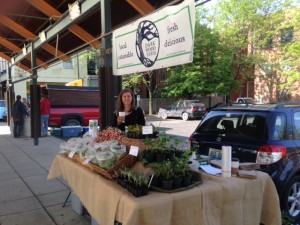
Last week was big for me and my fledgling farm. It was my debut at the farmers market, and the first time I could put a little bit of money in the bank after many months of preparation. With warmer weather and a little bit of rain, all that prep work is paying off – vegetables are growing by leaps and bounds every day. But the work isn’t over by any means! Now that the threat of frost is over, I will be planting warm weather crops: tomatoes, squash, cucumbers, peppers, eggplant, okra, beans, and basil.
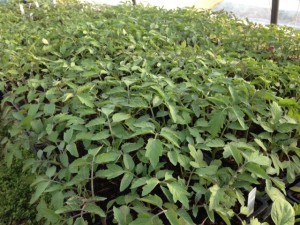
Once all of these crops are in the ground, my entire 1-acre field will be filled. That doesn’t mean that I can just sit back and watch the plants grow. As the weather steadily gets warmer, all my cool-loving plants like radishes, lettuces, and spring greens will begin to finish their life cycle by going to seed. At that point, they are no longer tasty, so I will mow them down, till them back into the soil, and rotate a new crop into that location. In this way, I will get almost two crop cycles out of my 1-acre garden, making it kind of like a 2-acre garden! To guide me in this process of cycling crops through the garden, I created a crop plan back during those really cold winter days. So far, the plan is pretty much on course, but I’ve had to adapt a little by pushing back my planting dates due to the long and cold winter this year. One crop that has been waiting patiently to go in the ground are my onions. I seeded them into flats that lived inside my house during February. In March, they went into the greenhouse, but still had to survive through some cold nights – you all remember those 16 degree nights, right? My hope was that they’d be big enough to plant out in the field by the end of March, but not so! They are still sizing up in my greenhouse and will hopefully go to live out in the garden in the next week or two. On the flip side, I started some brussels sprouts at the beginning of April thinking they would be planted out into the field around June 1.
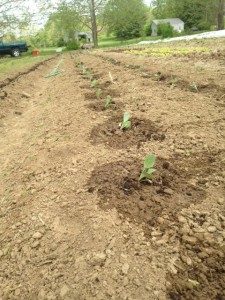
Well, they’ve been growing like crazy, so I planted them out in the field this week. That’s how it goes – the plants do their thing according to their own schedule and the weather, and it’s my job to observe them and adapt my plan as necessary to make sure they have the best growing environment possible.
Spring Greens
This weekend marks a momentous occasion for me and the farm – my first trip to the farmers market! Four busy months have passed since I moved onto my little piece of leased land down in Belleview Bottoms, and now it’s time for the vegetables of Dark Wood Farm to make their grand debut and start filling the bellies of folks around Northern Kentucky and Cincinnati. On Sunday, May 4 from 10AM-2PM, I’ll be bringing lots of spring greens to the farmers market at Findlay Market. Spring greens are a great source of vitamins, minerals, and fiber, which improve digestion and help your body detox after a long winter of heavy, fatty foods. As a bonus, most spring greens will enliven your taste buds with a spicy kick, bold nutty flavor, or bitter bite.


Most of the greens I’m bringing to market this week are in the mustard plant family, including arugula, french breakfast radishes, and Asian salad greens including mizuna and tatsoi. They went into the ground as seeds on March 24 and have grown happily through the cold, wind, rain, and even heat over the past 6 weeks. Their only nemesis during the spring months is a small, black, jumping insect called the flea beetle. Flea beetles emerge around the same time that the redbud trees bloom here in Kentucky, and when they start looking for food, they LOVE the spicy flavor of plants in the mustard family. Left unprotected from the flea beetle, spring mustards would look like they were blasted by a shotgun, with tiny holes all over the leaves. Some farmers prevent flea beetle damage by applying weekly doses of insecticides, but I don’t want to eat raw greens covered with chemicals, so I use fabric row covers to cover the vegetables that are most susceptible to flea beetle damage. Even so, some flea beetles find their way under the fabric and leave their trademark holes on my spring greens.
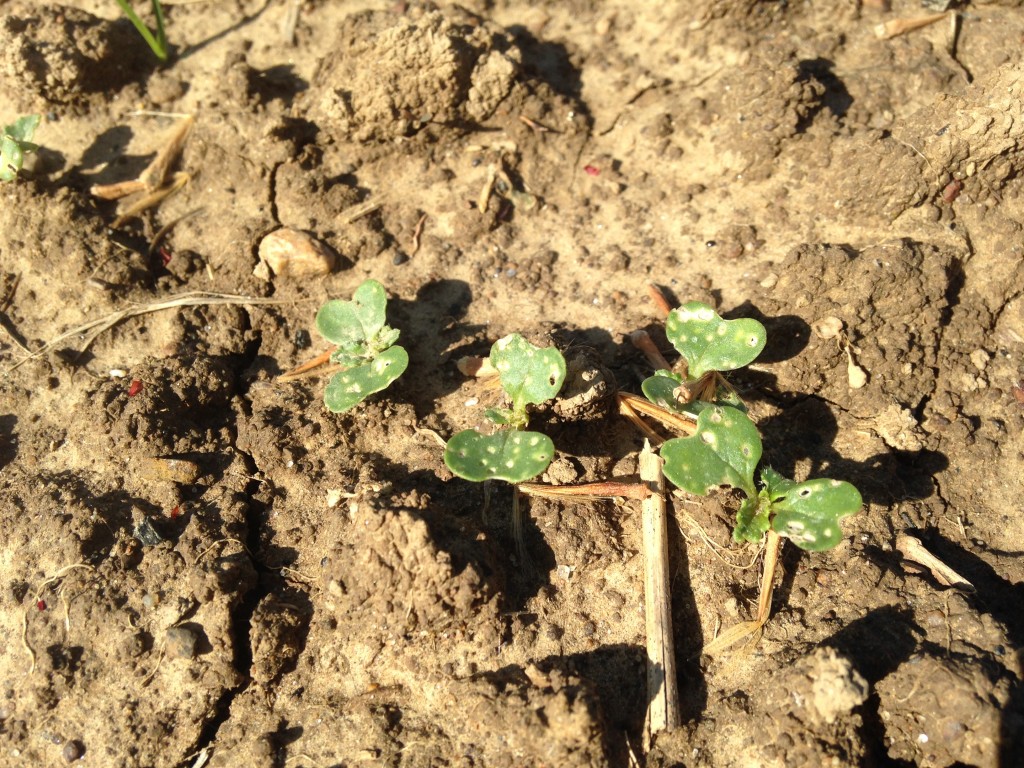

Since I cut spring greens by hand, I can check for flea beetle damage as I harvest. Really holey leaves get tossed on the ground become compost and feed the soil, but I do keep some leaves that have minimal damage from the flea beetle. The holes do nothing to affect the taste and quality of the vegetables, so if you find an arugula or radish leaf with a hole or two, don’t worry – in fact, rest assured that your veggies are free from chemicals and safe to eat.
